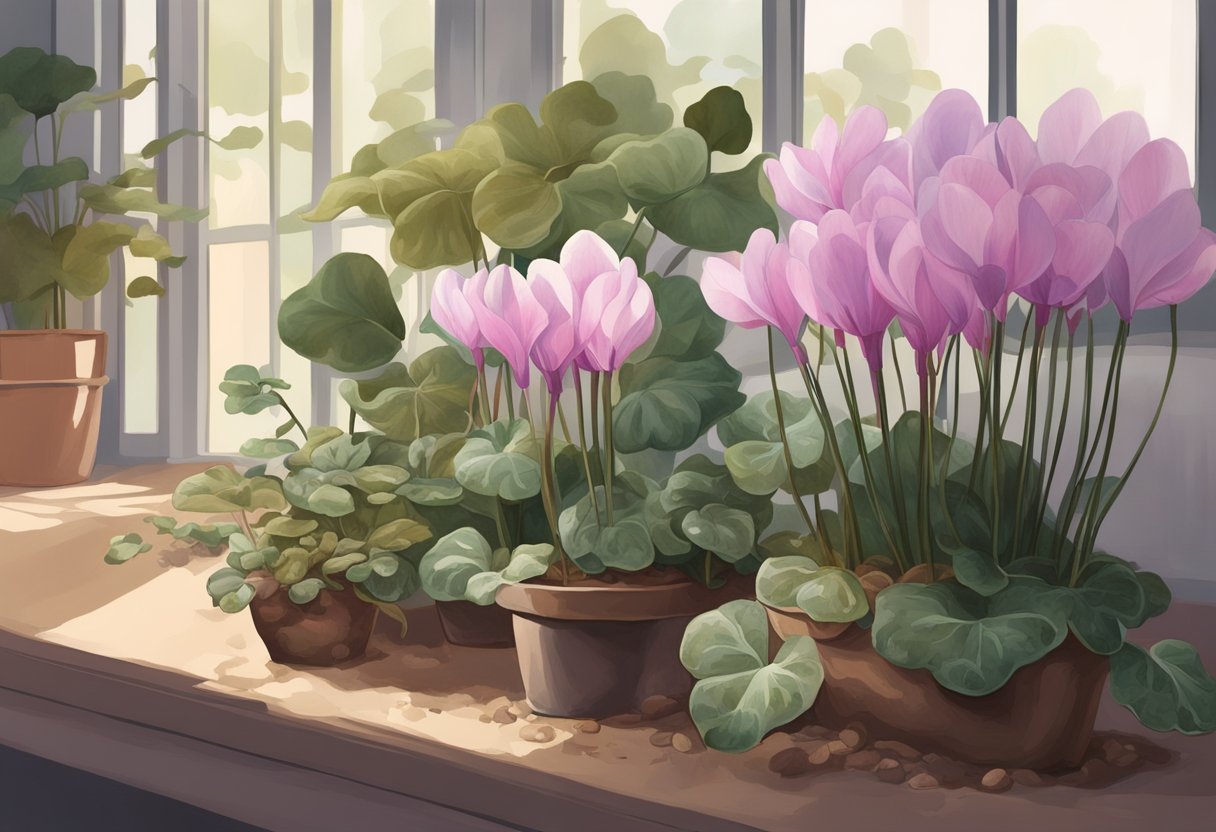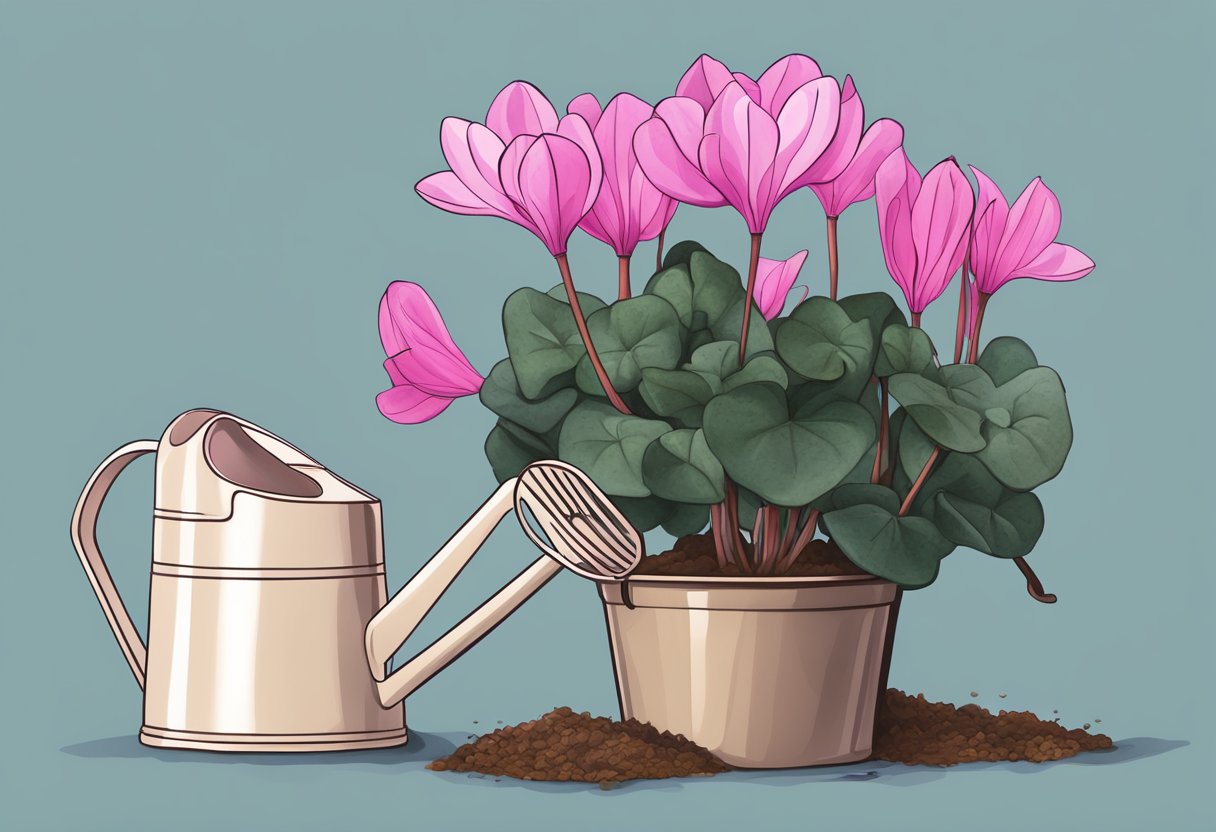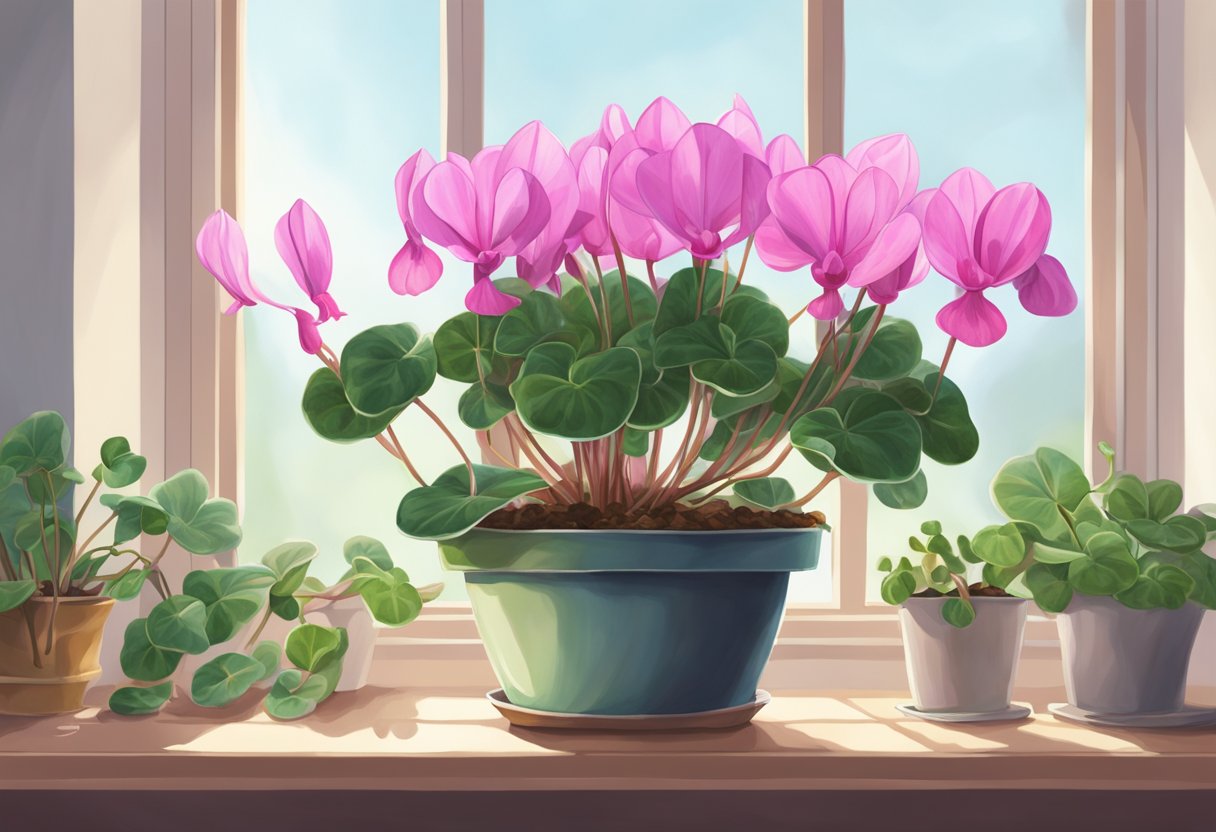How to Care for Cyclamen: Tips and Tricks for Healthy Plants
Cyclamen is a beautiful flowering plant that can brighten up any indoor space. However, caring for cyclamen can be tricky, as it requires specific conditions to thrive. In this article, we will provide you with expert tips on how to care for your cyclamen and ensure that it remains healthy and vibrant.

Firstly, it is important to note that cyclamen prefers cool temperatures and bright, indirect light. It is best to keep your cyclamen in a room with a temperature range of 50-65°F (10-18°C). Direct sunlight can scorch the leaves and cause damage, so it is recommended to place it near a window with filtered light.
When it comes to watering, cyclamen is a bit finicky. Overwatering can lead to root rot, while underwatering can cause the plant to wilt and die. It is best to water your cyclamen from the bottom, by placing the pot in a saucer of water for 10-15 minutes. This allows the plant to soak up water through the drainage holes without getting the leaves wet, which can lead to fungal infections.
Understanding Cyclamen

Cyclamen is a genus of flowering plants that belong to the family Primulaceae. These plants are native to the Mediterranean region and are known for their beautiful, fragrant flowers and attractive foliage. Cyclamen plants are popular among gardeners and are commonly used as indoor plants.
Botanical Profile
Cyclamen plants are herbaceous perennials that grow from tubers. They have heart-shaped leaves that are often variegated with shades of green, silver, and white. The flowers of cyclamen plants are unique and come in a wide range of colors, including pink, red, white, and purple.
Varieties of Cyclamen
There are many different varieties of cyclamen plants, each with its own unique characteristics. Some of the most popular varieties include Cyclamen persicum, Cyclamen coum, and Cyclamen hederifolium.
Cyclamen Persicum vs. Other Species
Cyclamen persicum, also known as florist’s cyclamen, is the most commonly grown species of cyclamen. It is prized for its large, showy flowers and is often used as a houseplant. However, there are many other species of cyclamen that are also worth considering.
Cyclamen coum, for example, is a hardy species that is well-suited to outdoor cultivation. It has small, delicate flowers that bloom in late winter or early spring. Cyclamen hederifolium, on the other hand, is a shade-loving species that is known for its attractive foliage.
In summary, cyclamen plants are a popular choice among gardeners due to their beautiful flowers and attractive foliage. There are many different varieties of cyclamen to choose from, each with its own unique characteristics. Cyclamen persicum is the most commonly grown species, but other species such as Cyclamen coum and Cyclamen hederifolium are also worth considering.
Planting and Repotting Cyclamen
Cyclamen plants are beautiful and delicate, and they require proper care to thrive. One of the most important aspects of caring for cyclamen is planting and repotting. In this section, we will discuss the steps you need to take to ensure your cyclamen plants are planted and repotted correctly.
Choosing the Right Soil
Choosing the right soil is crucial for the health of your cyclamen plant. Cyclamen plants prefer well-draining soil that is rich in organic matter. A good soil mix for cyclamen is one that contains peat moss, perlite, and vermiculite. This type of soil mix will provide the plant with the necessary nutrients and help prevent root rot.
Pot Selection and Drainage
When selecting a pot for your cyclamen plant, it is important to choose one that has drainage holes. This will ensure that excess water can drain out of the pot and prevent the roots from becoming waterlogged. A pot that is too large can also cause problems, as it can hold too much water and cause root rot. Choose a pot that is just slightly larger than the plant’s root ball.
Repotting Steps
Repotting your cyclamen plant is necessary when the plant outgrows its current pot or when the soil becomes compacted. To repot your cyclamen, follow these steps:
- Water the plant thoroughly a few hours before repotting.
- Gently remove the plant from its current pot, being careful not to damage the roots.
- Loosen the roots and remove any old soil.
- Place a layer of fresh soil in the bottom of the new pot.
- Place the plant in the new pot and fill in around the roots with fresh soil.
- Water the plant thoroughly and allow it to drain.
By following these steps, you can ensure that your cyclamen plant is planted and repotted correctly, which will help it thrive and produce beautiful flowers.
Cyclamen Care Essentials
Cyclamen is a popular houseplant known for its attractive foliage and beautiful flowers. To keep your cyclamen healthy and thriving, it’s important to follow some essential care guidelines. Here are some tips to help you care for your cyclamen:
Watering Requirements
Cyclamen plants prefer to be kept evenly moist, but not wet. Overwatering can lead to root rot and other problems. To keep the soil moist, water your cyclamen thoroughly when the top inch of soil feels dry to the touch. It’s important to avoid getting water on the foliage or flowers, as this can cause damage or disease.
Light and Temperature
Cyclamen plants prefer bright, indirect light and cool temperatures between 50-65°F (10-18°C). Direct sunlight can scorch the leaves and flowers, so it’s important to provide filtered or indirect light. Keep your cyclamen away from drafts and heat sources, as this can cause the foliage to wilt or dry out.
Fertilizing and Feeding
Cyclamen plants benefit from regular fertilizing during the growing season. Use a balanced, water-soluble fertilizer every 2-3 weeks to promote healthy growth and blooms. Be sure to follow the instructions on the fertilizer package, as over-fertilizing can cause damage to the plant.
In addition to regular fertilizing, it’s also important to provide good air circulation and high humidity for your cyclamen plant. This can be achieved by placing a tray of water near the plant or by using a humidifier.
By following these essential care guidelines, you can keep your cyclamen healthy and beautiful for years to come.
Maintaining Healthy Growth

Cyclamen is a beautiful flowering plant that can add a pop of color to any indoor or outdoor space. To ensure that your cyclamen stays healthy and vibrant, it is important to maintain its growth through proper care and maintenance. Here are some tips on how to keep your cyclamen healthy and thriving.
Pruning and Deadheading
Pruning and deadheading are essential to maintain the health and beauty of your cyclamen. Deadheading is the process of removing dead or wilted flowers from the plant. This helps to encourage new growth and prolong the blooming period. Pruning, on the other hand, involves cutting back the plant to promote new growth and maintain its shape.
To deadhead your cyclamen, simply pinch off the dead flowers at the base of the stem. For pruning, use a clean, sharp pair of scissors or shears to cut back any yellowing or damaged leaves. Be careful not to cut into the tuber, as this can damage the plant.
Managing Dormancy
Cyclamen is a perennial plant that goes through a dormant period. During this time, the plant will naturally lose its leaves and stop blooming. To manage dormancy, reduce watering and stop fertilizing the plant. Keep the soil slightly moist, but not wet, and place the plant in a cool, dark place for several weeks.
After the dormant period, the cyclamen will begin to grow new leaves and buds. Once new growth appears, move the plant back into a bright, sunny location and resume regular watering and fertilizing.
Pests and Disease Control
Cyclamen can be susceptible to pests and diseases, such as cyclamen mites and fungal infections. To prevent these issues, make sure to keep the plant in a well-ventilated area and avoid overwatering. If you notice any signs of pests or disease, such as yellowing leaves or distorted growth, treat the plant with a suitable insecticide or fungicide.
Regularly inspecting your cyclamen for signs of pests and disease, and taking prompt action to address any issues, can help to ensure that your plant stays healthy and vibrant.
By following these simple tips for maintaining healthy growth, you can enjoy the beauty of your cyclamen for years to come.
Seasonal Cyclamen Care

Summer Care for Dormant Cyclamen
During the summer, cyclamen goes dormant and requires less attention. It is important to keep the soil slightly moist but not too wet. Overwatering can lead to root rot, while underwatering can cause the plant to dry out and die. It is recommended to water the plant once a week and to avoid getting water on the leaves and flowers.
Cyclamen prefers a cool spot during the summer months. It is important to keep the plant away from direct sunlight and to provide it with enough ventilation. If the plant is kept in a hot and humid environment, it can become susceptible to pests and diseases.
Winter Care for Active Growth
Cyclamen is actively growing during the winter months and requires more attention. It is important to keep the soil moist but not too wet. Overwatering can lead to root rot, while underwatering can cause the plant to dry out and die. It is recommended to water the plant once or twice a week, depending on the humidity and temperature of the room.
Cyclamen prefers a cool spot during the winter months. It is important to keep the plant away from direct sunlight and to provide it with enough ventilation. If the plant is kept in a hot and humid environment, it can become susceptible to pests and diseases.
During the winter, cyclamen benefits from regular fertilization. It is recommended to use a balanced fertilizer once a month to promote healthy growth and flowering. Deadheading spent flowers can also encourage new growth and prolong the blooming period.
Overall, by following these simple tips, one can ensure healthy growth and blooming of cyclamen throughout the year.
Propagation and Increasing Cyclamen

Cyclamen can be propagated from both seeds and tubers. Here are the two main methods for propagating cyclamen:
Seed Propagation
Cyclamen seeds should be sown in late spring or early summer, as soon as they are ripe. The seeds should be sown in a well-draining soil mix that is high in sphagnum peat. The seeds should be covered with a thin layer of soil and kept moist.
The seeds will germinate in about two to three weeks. Once the seedlings have developed their second set of leaves, they can be transplanted to individual pots. It is important to keep the soil moist but not waterlogged.
It will take about two to three years for the cyclamen to reach maturity and start producing flowers.
Dividing Tubers
Cyclamen can also be propagated by dividing the tubers. This method is best done in the fall, after the plant has finished flowering.
To divide the tubers, gently remove the plant from its pot and carefully separate the tubers. Each tuber should have at least one growing point and a small amount of root attached.
Replant each tuber in a pot filled with a well-draining soil mix that is high in sphagnum peat. Water the plant well and keep it in a cool, bright location.
Propagation is a great way to increase your collection of cyclamen. With a little patience and care, you can have a beautiful collection of these lovely plants in no time.
Special Considerations

Cyclamen Toxicity
Cyclamen plants are toxic to humans and pets. The plant contains cyclamine, a toxic compound that can cause symptoms such as vomiting, diarrhea, and even death if ingested in large quantities. It is important to keep the plant out of reach of children and pets.
Cyclamen as Gifts
Cyclamen plants make great gifts due to their beautiful blooms and long-lasting nature. However, it is important to inform the recipient of the plant’s toxicity and to keep it out of reach of children and pets. If the recipient has pets, it may be best to choose a different type of plant as a gift.
When giving a cyclamen plant as a gift, it is important to provide care instructions to ensure the plant thrives. The recipient should be informed that the plant prefers bright, indirect light and should be watered from the bottom to prevent water from getting on the leaves and causing damage.
In conclusion, while cyclamen plants are beautiful and long-lasting, they require special considerations due to their toxicity. When caring for a cyclamen plant, it is important to keep it out of reach of children and pets, and to provide proper care instructions if giving as a gift.
Aesthetic Aspects of Cyclamen

Cyclamen plants are prized for their beautiful and delicate blooms, as well as their attractive foliage. In this section, we will explore the aesthetic aspects of cyclamen, including their color variations and how to display and place them in your home.
Color Variations
Cyclamen plants come in a range of colors, including red, pink, white, and purple. Some varieties even have variegated leaves, adding an extra layer of interest to their appearance. The heart-shaped leaves of cyclamen plants are also a beautiful feature that adds to their overall aesthetic.
When selecting cyclamen plants for your home, consider the color scheme of the room where they will be displayed. Red cyclamen plants, for example, can add a pop of color to a neutral room, while pink and white varieties can complement a more colorful space.
Display and Placement
Cyclamen plants are versatile and can be displayed in a variety of ways. They are commonly used as indoor plants and can thrive in partial shade. When placing your cyclamen plant, make sure it is not exposed to direct sunlight, as this can cause the leaves to wilt.
Florist’s cyclamen, also known as Persian cyclamen, are often sold in decorative pots and can be used as a centerpiece on a table or displayed on a windowsill. They can also be planted in a hanging basket or placed on a pedestal for added height.
When displaying your cyclamen plant, consider the bloom time. Cyclamen plants typically bloom from late fall to early spring, so they can be a great way to add color to your home during the winter months.
Overall, cyclamen plants are a beautiful addition to any home. With their range of colors and attractive foliage, they can add a touch of elegance to any space.
Troubleshooting Common Issues

Overwatering and Drainage Problems
One of the most common issues with cyclamen is overwatering. Cyclamen plants prefer well-draining soil, and excessive watering can lead to root rot, yellow leaves, and wilting. To prevent overwatering, make sure the pot has drainage holes and use a well-draining potting mix.
If the plant is already showing signs of overwatering, the first step is to stop watering it immediately. Allow the soil to dry out completely before watering again. In severe cases, it may be necessary to repot the plant in fresh, well-draining soil.
Addressing Yellow and Fading Leaves
Yellow leaves are a common symptom of overwatering, but they can also be caused by underwatering or nutrient deficiencies. If the leaves are yellowing, check the soil moisture level and adjust watering accordingly. If the soil is dry, water the plant thoroughly and make sure it is draining properly. If the soil is wet, allow it to dry out before watering again.
Fading flowers are a natural part of the cyclamen’s growth cycle, but yellowing leaves can be a sign of a problem. If the leaves are yellowing from the base of the plant, it could be a sign of nutrient deficiency. In this case, fertilize the plant with a balanced, water-soluble fertilizer every two weeks.
In summary, overwatering and poor drainage are common issues with cyclamen plants. To prevent these problems, use well-draining soil and make sure the pot has drainage holes. If the plant is already showing signs of overwatering, stop watering immediately and allow the soil to dry out. Yellowing leaves can be a sign of overwatering, underwatering, or nutrient deficiencies, so check the soil moisture level and fertilize as needed.
Frequently Asked Questions
What are the best practices for watering cyclamen plants?
Cyclamen plants require moderate watering, and it is important to avoid overwatering them. The soil should be kept moist but not waterlogged. Watering should be done from the bottom, and any excess water should be drained away. It is also important to avoid getting water on the leaves or flowers, as this can lead to rot.
How do I maintain cyclamen after the blooming period?
After the blooming period, the cyclamen plant will enter a dormant phase. During this time, the plant should be watered less frequently and allowed to dry out slightly between waterings. The leaves will begin to yellow and die back, and the plant should be allowed to rest until the following growing season.
What is the difference in care requirements for indoor versus outdoor cyclamen?
Indoor and outdoor cyclamen have different care requirements. Indoor cyclamen should be kept in a cool, bright location away from direct sunlight, and should be watered sparingly. Outdoor cyclamen should be planted in a well-draining soil and watered regularly. They should also be protected from frost and extreme temperatures.
When do cyclamen typically enter their dormant phase, and how should they be cared for during this time?
Cyclamen typically enter their dormant phase in the summer months. During this time, the plant should be watered less frequently and allowed to dry out slightly between waterings. The leaves will begin to yellow and die back, and the plant should be allowed to rest until the following growing season.

